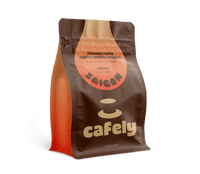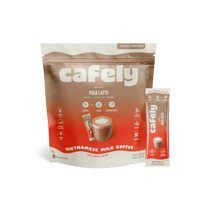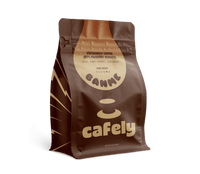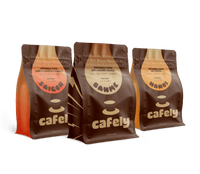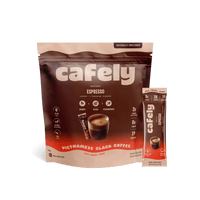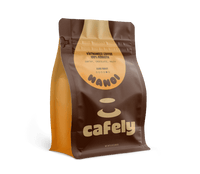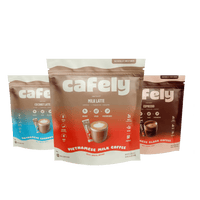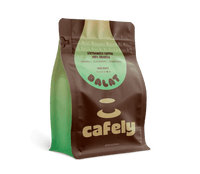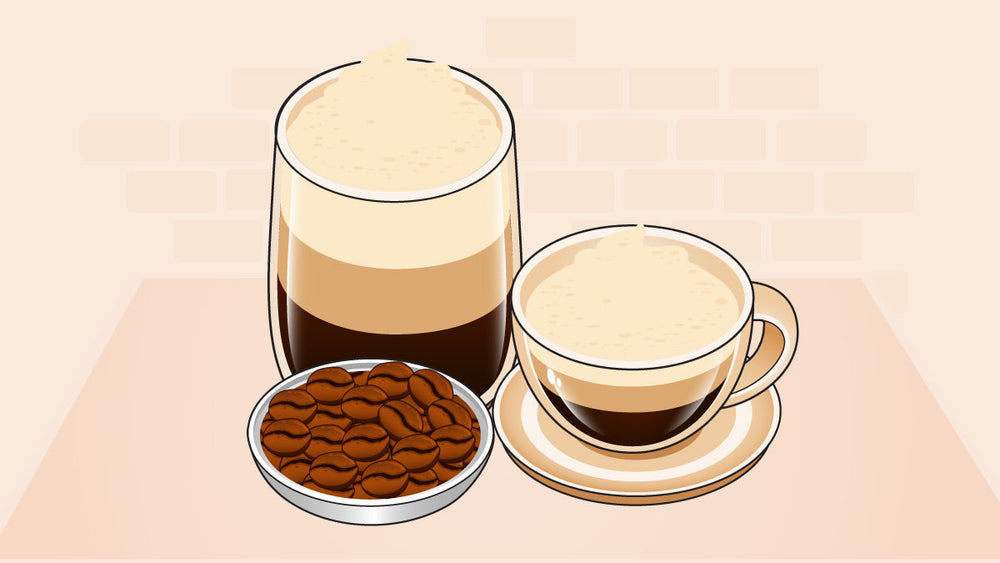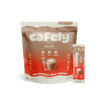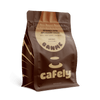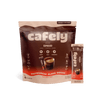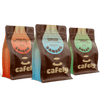The cappuccino coffee is a mild, creamy brew with a velvety texture. Steamed milk highlights the bold, smooth flavors of arabica espresso. The cappuccino is often presented in a large round coffee cup and is finished with “latte art” and a dash of fine coffee powder.
In this article, you'll learn all about this classic Italian beverage and how to make the perfect cup at home.
What is Cappuccino Coffee?
The cappuccino is a classic Italian beverage that's made with espresso and steamed milk. A traditional Italian cappuccino is made using one part arabica espresso, one part steamed milk, and one part milk foam (1:1:1 ratio).
Appearance of Cappuccino Coffee
The cappuccino is a visually distinctive brew. It’s often served in medium to large round coffee cups between 150 and 240 mL. It has a thick, frothy layer of milk foam on top, which is bright, smooth, and silky in texture.
Baristas may also add artistic touches by creating latte art designs such as rosettas, hearts, and leaves on top. The cappuccino may also be dusted with a fine coffee or chocolate powder, which settles on top of the foam.
Taste of Cappuccino Coffee
The cappuccino offers a balanced and layered taste experience. It can be compared to a coffee latte in terms of flavor because both brews contain a similar espresso-to-milk ratio.
The espresso base of the cappuccino gives a bold, nutty, slightly bitter coffee flavor. The steamed milk mellows the coffee flavors out, and the fine microfoam adds a thick, airy texture.
What You Need to Make Cappuccino Coffee

The cappuccino coffee is relatively simple in terms of ingredients. You can make a cup with just coffee, water, and milk. However, you do need an espresso machine with a steam wand and a few other pieces of specialist equipment.
Here’s what you need to make cappuccino coffee at home:
Equipment
- Espresso Machine — An espresso machine such as the Breville Barista is essential if you want to make a cappuccino coffee.
- Coffee Measuring Spoon — A coffee measuring spoon or scale allows you to accurately measure the coffee for your espresso shot.
- Steaming Pitcher — You'll need a stainless steel pitcher to steam the milk and create the foam.
- Large Coffee Mug — A large round coffee mug is perfect for a cappuccino.
Ingredients
- High-Quality Coffee — A whole-bean arabica coffee is best for making cappuccino.
- Water — Use cold, fresh, filtered water in your espresso machine.
- Milk — Whole milk is needed to make cappuccino. For a vegan brew, opt for oat or almond milk.
Best Coffee for Making Cappuccino
The best coffee for making cappuccino is whole-bean arabica. A high-quality dark roast such as our DaLat Coffee is the best option. Grinding your beans fresh just before brewing will produce the most charismatic cup with the richest flavor profile.
Although cappuccino is traditionally made with arabica beans, you can experiment with other types of coffee.
Try a 100% robusta coffee for a bold, dark, slightly bitter cappuccino with a strong caffeine content. We recommend Hanoi (100% robusta) or BanMe (100% peaberry robusta) if you’re looking to experiment with a high-caffeine coffee variety.
Blends can also work to create interesting, balanced cappuccinos. An arabica and robusta blend such as Saigon OG offers the best of both beans. You’ll get the smooth sweetness of arabica and the dark, bold strength of robusta.
How to Make Cappuccino Coffee: Step-by-Step Guide
Making a cappuccino is relatively simple. However, achieving the velvety texture and microfoam of the milk can take some practice.
Here's how to make a deliciously velvety cappuccino:
1. Measure and Grind the Coffee
First, measure and grind the coffee. A single-shot cappuccino requires 9 grams of coffee and a double requires 18 grams. Place the beans in the grinder of your machine and grind them to a fine consistency similar to powdered sugar.
2. Fill Your Portafilter
Fill your portafilter with the ground coffee and press it down with your tamper. Apply even, firm pressure but don’t overdo it — over-tamped coffee can lead to an uneven extraction.
3. Brew the Espresso
Lock the portafilter into the group head of your espresso machine. Pull the shot into a large coffee cup and time the extraction. An espresso requires a 25 to 30-second extraction.
4. Steam the Milk
Steam your milk until it becomes thick, velvety, and foamy. Give the pitcher a couple of taps on the counter after steaming to incorporate some of the foam into the center of the milk pitcher.
5. Assemble the Cappuccino
Gently pour the steamed milk into the cup, moving back and forth to incorporate the milk with the espresso. Fill the cup to just below the rim and top with a dusting of chocolate or coffee powder (if desired).
Cappuccino is served at drinking temperature, so enjoy your brew right away.
Similar Espresso-Based Brews to the Cappuccino

The cappuccino is one of many beverages you can make with an espresso machine. Three espresso-based coffees are particularly similar to the cappuccino. The latte, flat white, and macchiato coffees all contain espresso coffee and steamed milk.
Here's how these beverages differ from the cappuccino:
1. Latte
The latte (or caffè latte) is a creamy beverage made with espresso and steamed milk. It has a light and velvety texture and a thinner mouthfeel than cappuccino. To enhance the smoothness and flavor this drink is known for, start by choosing the best coffee beans for latte.
The cappuccino and latte are very similar. The difference lies in the ratio of espresso, steamed milk, and milk foam, which affects the texture, flavor, and overall experience of the beverage.
Here’s how the latte and cappuccino differ:
- Cappuccino has a 1:1:1 ratio of espresso, steamed milk, and microfoam.
- The latte has a 1:3 ratio of espresso to steamed milk, with a small amount of light foam on top.
2. Flat White
The flat white is a light, strong cup of coffee made with espresso and steamed milk. It’s made with a double shot of espresso and has a thick layer of small, even microbubbles. The flat white gets its name because it's poured up to the rim of the cup — leaving a “flat, white” layer of microfoam on top.
The cappuccino and flat white are similar. However, the ratio of coffee to milk and the texture of the foam are different.
Here’s how the cappuccino and flat white differ:
- Cappuccino coffee has a 1:1:1 ratio of espresso, steamed milk, and microfoam. It has a thick and creamy texture.
- The flat white contains a 1:3 ratio of espresso to steamed milk — similar to the latte. However, the milk is gently steamed to create a light and airy microfoam.
3. Macchiato
The macchiato is a strong, intense coffee made with espresso and steamed milk. It’s a concentrated coffee with a touch of microfoamed milk rather than a milk-heavy coffee-to-milk ratio like the latte, cappuccino, and flat white.
Here’s how the macchiato differs from the cappuccino:
- Cappuccino has a 1:1:1 ratio of espresso, steamed milk, and microfoam and tastes rich and creamy. It has a mild arabica coffee taste.
- Macchiato coffee contains a single or double shot of espresso and a small amount of microfoam. The microfoam milk floats on top of the shot and takes the bitter edge off the coffee but not its bold characteristics.
FAQs: Cappuccino Coffee
Want to learn more about cappuccino coffee and other similar brews?
Check out the answers to the frequently asked questions below:
1. What’s the Difference Between a Cappuccino and a Latte?
The difference between cappuccino and latte lies in their composition. The Cappuccino contains equal parts of espresso, steamed milk, and milk foam. The latte contains one part espresso and three parts steamed milk.
2. What’s the Difference Between a Cappuccino and a Flat White?
The cappuccino contains equal parts espresso, steamed milk, and milk foam (1:1:1 ratio). The flat white contains a double shot of espresso coffee topped with a smaller amount of steamed milk and microfoam.
3. How Much Caffeine is in a Cappuccino?

There’s around 75 mg to 150 mg of caffeine in a cup of cappuccino made with arabica espresso. The amount of caffeine in every cup can vary depending on the amount of espresso used and the bean type used to make it.
4. Can You Make a Cappuccino Without an Espresso Maker?
You can’t make a traditional cappuccino without an espresso maker. However, you can make a similar brew by brewing a concentrated coffee and adding warm frothed milk.
5. Can You Make Cappuccino Vegan?
Yes. You can make cappuccino by swapping out the dairy milk for a plant-based alternative. Oat milk, almond milk, and coconut milk are good alternatives for making a vegan cappuccino.
6. Does a Moka Pot Make Espresso?
The moka pot is a simple stove-top coffee maker. It can make coffee that’s similar to espresso. It works by forcing hot, pressurized water up through finely ground coffee. If you don’t have an espresso machine or want to make espresso-like coffee on the go, this is one of the best options.
7. Can You Make Cappuccino With Instant Coffee?
You can’t make a traditional cappuccino with instant coffee. However, instant cappuccino blends and instant lattes can produce a similar-tasting brew in minutes. You can also use instant espresso and warm and froth milk on the stove to make a cappuccino-like brew.
8. What’s the Difference Between an Espresso and Ristretto Shot?
Espresso and ristretto are both strong coffee shots made using an espresso machine. The espresso uses a 1:2 coffee-to-water ratio, whereas the ristretto uses a 1:1 ratio, making it much more intense.
9. What’s the Best Coffee to Use for Cappuccino?
The best coffee to use for making cappuccino should be high-quality and freshly ground. A traditional cappuccino calls for 100% arabica beans such as DaLat.
10. Can You Make Steamed Milk Without an Espresso Machine?
You can make frothed milk that will have a similar texture to steamed milk without an espresso machine. To froth milk, warm it on a pan and froth it using a fine whisk or milk frother until a fine, velvety texture has been created.
